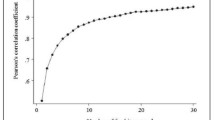Abstract
Zinc is an essential nutrient required for numerous metabolic functions. The aim of the present study was to develop a zinc-specific food frequency questionnaire (FFQ) and to determine its relative validity. A 74-item FFQ was designed for the measurement of zinc intake. Food items were included in the FFQ if their zinc content was >0.5 mg/100 g, and the food item contributed >5% of the recommended dietary intake. Female subjects (n = 22) were recruited to complete the questionnaire in addition to maintaining a weighed food record for 7 days. Mean intake of zinc obtained from the weighed records (8.8 ± 2.3 mg/day; mean ± SD) was significantly lower than that obtained from the FFQ (10.5 ± 3.1 mg/day; P < 0.01). Ranked zinc intakes obtained from the two instruments were significantly correlated (r s = 0.81, P < 0.001). Evaluation of progressively shortened versions of the FFQ, containing 23–61 food items and representing 60–90% of the contribution to total zinc intake, yielded correspondingly decreasing magnitudes of zinc intake, but the rank correlation with the weighed records was significant (P < 0.01). Rank correlations and analysis of plots from Bland–Altman analyses suggest that a shortened 37-item FFQ has comparable validity to the full FFQ. A shortened FFQ is likely to produce lower demands on the interviewer and/or respondent when assessing zinc intake.



Similar content being viewed by others
References
King JC, Cousins RJ (2006) Zinc. In: Shils ME, Shike M, Ross AC, Caballero B, Cousins RJ (eds) Modern nutrition in health and disease, 10th edn. Lippincott Williams & Wilkins, Philadelphia, pp 271–285
Samman S (2007) Zinc. In: Mann JI, Truswell AS (eds) Essentials of human nutrition, 3rd edn. Oxford University Press, Oxford, pp 138–142
Mantzoros CS, Prasad AS, Beck FWJ et al (1998) Zinc may regulate serum leptin concentrations in humans. J Am Coll Nutr 17:270–275
Chimienti F, Devergnas S, Favier A, Seve M (2004) Identification and cloning of a beta-cell-specific zinc transporter, ZnT-8, localized into insulin secretory granules. Diabetes 53:2330–2337
Kirchhoff K, Machicao F, Haupt A et al (2008) Polymorphisms in the TCF7L2, CDKAL1 and SLC30A8 genes are associated with impaired proinsulin conversion. Diabetologia 51:597–601
Sladek R, Rocheleau G, Rung J et al (2007) A genome-wide association study identifies novel risk loci for type 2 diabetes. Nature 445:881–885
World Health Organization (2002) The World Health Report 2002: reducing risks, promoting healthy lifestyles. World Health Organization, Geneva
International Zinc Nutrition Consultative Group (IZiNCG) Technical Document #1 (2004) Assessment of the risk of zinc deficiency in populations and options for its control. Food Nutr Bulletin 25(Suppl 2):S95–S203
Nelson M, Black AE, Morris JA et al (1989) Between- and within- subject variation in nutrient intake from infancy to old age: estimating the number of days required to rank dietary intakes with desired precision. Am J Clin Nutr 50:155–167
Department of Health and Ageing (2006) Nutrient reference values for Australia and New Zealand. Executive Summary. Commonwealth of Australia, Canberra
Australian Bureau of Statistics (1998) National Nutrition Survey. Nutrient Intakes and Physical Measurements Australia 1995. Commonwealth of Australia, Canberra
Cade J, Thompson R, Burley V et al (2002) Development, validation and utilisation of food-frequency questionnaires – a review. Public Health Nutr 5:567–587
Bland JM, Altman DG (1986) Statistical methods for assessing agreement between two methods of clinical measurement. Lancet 1(8476):307–310
Papadaki A, Scott JA (2007) Relative validity and utility of a short food frequency questionnaire assessing the intake of legumes in Scottish women. J Hum Nutr Diet 20:467–75
Lacey JM (2007) Zinc-specific food frequency questionnaire. Can J Diet Prac Res 68:150–152
Cade JE, Burley VJ, Warm DL et al (2004) Food-frequency questionnaires: a review of their design, validation and utilization. Nutr Res Rev 17:5–22
Sandstrom B (1997) Bioavailability of zinc. Eur J Clin Nutr 51(Suppl 1):S17–S19
Gibson RS (2005) Principles of nutritional assessment, 2nd edn. Oxford University Press, New York
Prasad AS (1984) Discovery and importance of zinc in human nutrition. Fed Proc 43:2829–2834
Gibson RS (2006) Zinc: the missing link in combating micronutrient malnutrition in developing countries. Proc Nutr Soc 65:51–60
World Health Organization (1996) Trace elements in human nutrition and health. World Health Organization, Geneva
Ball MJ, Ackland ML (2000) Zinc intake and status in Australian vegetarians. Br J Nutr 83:27–33
Baghurst K, Record S, Leppards P (2000) Red meat consumption in Australia: intakes, nutrient composition and changes over time. Aust J Nutr Diet 57:S3–S36
Author information
Authors and Affiliations
Corresponding author
Rights and permissions
About this article
Cite this article
Samman, S., Herbert, J., Petocz, P. et al. Development and Validation of a Short Questionnaire for Estimating the Intake of Zinc. Biol Trace Elem Res 134, 226–234 (2010). https://doi.org/10.1007/s12011-009-8466-y
Received:
Accepted:
Published:
Issue Date:
DOI: https://doi.org/10.1007/s12011-009-8466-y




